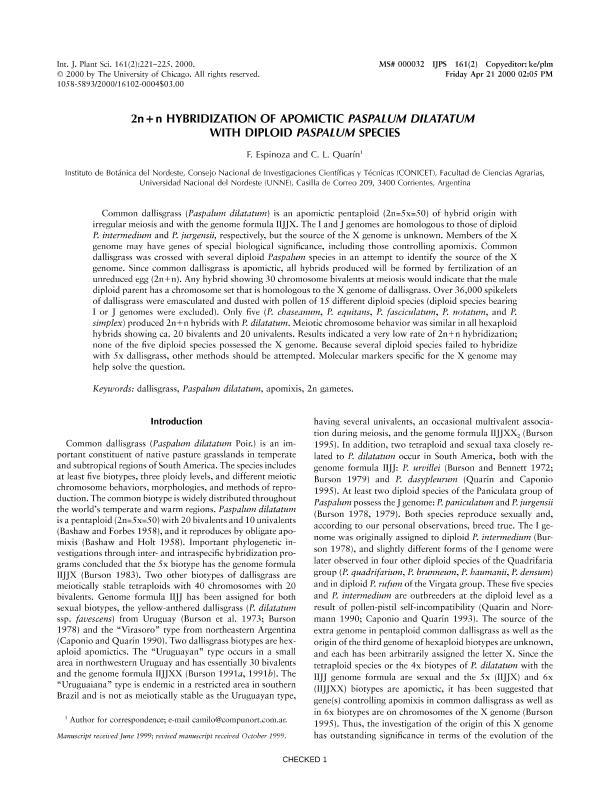Artículo
2 n + n hybridization of apomictic Paspalum dilatatum with diploid Paspalum species
Fecha de publicación:
04/2000
Editorial:
University of Chicago Press
Revista:
International Journal of Plant Sciences
ISSN:
1058-5893
e-ISSN:
1537-5315
Idioma:
Inglés
Tipo de recurso:
Artículo publicado
Clasificación temática:
Resumen
Common dallisgrass (Paspalum dilatatum) is an apomictic pentaploid (2n=5x=50) of hybrid origin with irregular meiosis and with the genome formula IIJJX. The I and J genomes are homologous to those of diploid P. intermedium and P. jurgensii, respectively, but the source of the X genome is unknown. Members of the X genome may have genes of special biological significance, including those controlling apomixis. Common dallisgrass was crossed with several diploid Paspalum species in an attempt to identify the source of the X genome. Since common dallisgrass is apomictic, all hybrids produced will be formed by fertilization of an unreduced egg (2n1n). Any hybrid showing 30 chromosome bivalents at meiosis would indicate that the male diploid parent has a chromosome set that is homologous to the X genome of dallisgrass. Over 36,000 spikelets of dallisgrass were emasculated and dusted with pollen of 15 different diploid species (diploid species bearing I or J genomes were excluded). Only five (P. chaseanum, P. equitans, P. fasciculatum, P. notatum, and P. simplex) produced 2n1n hybrids with P. dilatatum. Meiotic chromosome behavior was similar in all hexaploid hybrids showing ca. 20 bivalents and 20 univalents. Results indicated a very low rate of 2n1n hybridization; none of the five diploid species possessed the X genome. Because several diploid species failed to hybridize with 5x dallisgrass, other methods should be attempted. Molecular markers specific for the X genome may help solve the question.
Palabras clave:
Dallisgrass
,
Apomixis
,
2n Gametes
,
Biii Hybrids
Archivos asociados
Licencia
Identificadores
Colecciones
Articulos(IBONE)
Articulos de INST.DE BOTANICA DEL NORDESTE (I)
Articulos de INST.DE BOTANICA DEL NORDESTE (I)
Citación
Espinoza, Francisco; Quarin, Camilo Luis; 2 n + n hybridization of apomictic Paspalum dilatatum with diploid Paspalum species; University of Chicago Press; International Journal of Plant Sciences; 161; 2; 4-2000; 221-225
Compartir




